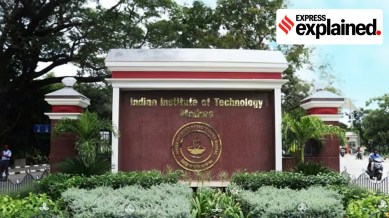How did IIT-Madras conclude there were no malpractices in the NEET-UG examination?
The government's affidavit before the Supreme Court includes an analysis of examination data over a range of parameters. The report of the analysis has concluded that the bell curve suggests normality.

Written by Adhya Joshi
On Thursday (July 18), the Supreme Court will resume hearing petitions asking for a cancellation of the May 5 NEET-UG on the ground that the integrity of the process had been compromised.
On July 10, the government had submitted an affidavit to the court saying data analytics of the exam results by IIT-Madras show “neither any indication of mass malpractice nor a localised set of candidates being benefitted leading to abnormal scores”.
Earlier on July 8, a Bench headed by Chief Justice of India (CJI) D Y Chandrachud had said that the decision on repeating the entire exam process would depend on whether the breach was systemic, or the beneficiaries of the fraud could be separated from the untainted examinees. The court had asked “whether it would be feasible using data analytics” to “identify suspect or suspicious cases”.
So where did IIT-Madras come into the picture?
The Department of Higher Education in the Ministry of Education had asked the Director of IIT-Madras, Prof V Kamakoti, for a comprehensive analysis of the results data to ascertain whether there were “any suspected cases who could have indulged in wrongdoing”, indicating “any aberration in the spread of top performers/ candidates”.
The institute was also requested to devise a set of parameters to form the basis of the analytics.
What were the findings in the IIT-Madras report?
NO MALPRACTICE: The report, which was part of the affidavit filed by the National Testing Agency (NTA), which gives NEET-UG, concluded there was no indication of abnormality in the results of the exam. There was “neither any indication of malpractice nor a localized set of candidates being benefitted leading to abnormal scores”, the report said.
It submitted that the analysis was granular enough to indicate any abnormality in case of a malpractice benefitting any localised set of candidates.
MARKS SPIKE, BUT THERE IS AN EXPLANATION: The report noted an overall inflation in marks obtained, especially in the 550-720 range. However, it reasoned that this spike had been observed in all centres across the country, and attributed it to the 25% reduction in the syllabus.
Some complex sections in the physics, chemistry, and biology syllabi had been removed by the NEET syllabus committee in consultation with state and central boards to reduce the stress on students and to synchronise the syllabi of higher education and NEET-UG.
NO SIGNIFICANT INCREASE IN TOPPERS IN SPECIFIC CITIES: The report included numerous comparisons between the NEET-UG results of 2023 and 2024, on various parameters. In the city-wise spread of the top 500 rankers, a comparative analysis of Sikar, Kota, and Patna showed that while the two Rajasthan cities had more candidates in the top 500 compared to 2023, Patna, where the question paper leak is alleged to have taken place, had one fewer candidate in this band in 2024 than in 2023.
Thus, the report concluded, “there has been no significant spike in the number of toppers” in any city, and that the “negative trend” in Patna, where the CBI is carrying out an investigation, suggested there was no localised area of malpractice.
What parameters did the analysis look at?
The evaluation used parameters such as marks distribution, city-wise and centre-wise rank distribution, and candidates spread over marks ranges. The data for all candidates were plotted as a graph, which appeared as a bell-shaped curve. The report said that such a graph is witnessed in any large exam, and is the first data-based evidence that there was no abnormality.
The city-wise and centre-wise analyses were carried out for the top 1.4 lakh ranks, given that the total number of seats across the country is around 1.1 lakhs, and for the top 500, 1,000, 5,000 and 60,000 segments.
The city-wise spread showed Sikar, Kota and Kottayam leading the toppers’ lists, which was justified on the grounds that these cities are home to many coaching centres. However, there was no spike in the number of top rankers in any particular centre in 2024 compared with 2023, indicating there were no localized malpractices.
Are the conclusions drawn by the II-Madras analysis on NEET sound?
Some experts and observers have expressed doubts over the claims of accuracy and granular analysis made by the IIT-Madras report.
Prof Dheeraj Sanghi, a former professor at IIT-Kanpur who is currently the acting Vice Chancellor at JK Lakshmipat University, Jaipur, said that a bell-shaped curve is not how a graph plotted for exams such as JEE and NEET should look like. No inference on anomalies can be drawn “just by looking” at the bell curve: “If 3% of candidates have cheated, the graph will only reflect it if they all get similar marks, which is not possible,” he said.
Prof Sanghi also said that attributing the increase in marks to the 25% cut in the syllabus could be a hasty conclusion that would have to be backed statistically. A comparative analysis among students within various ranges of percentile could better explain the spike in total marks, he said.
Adhya Joshi is an intern with The Indian Express